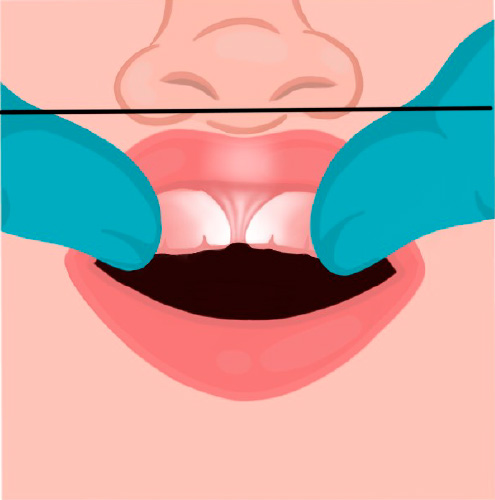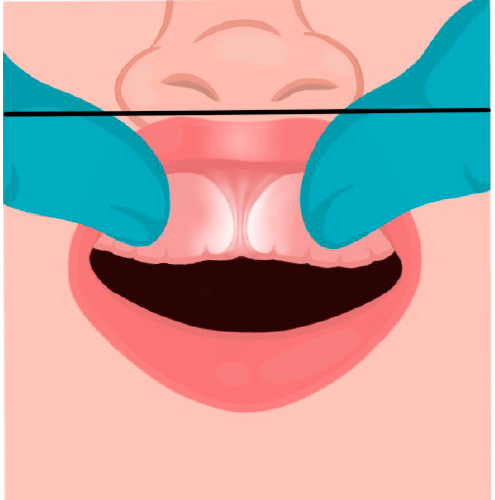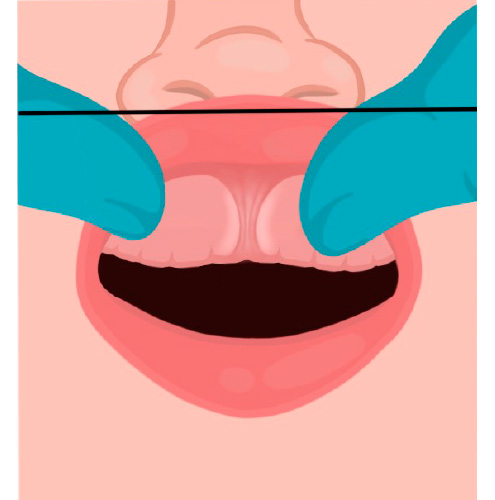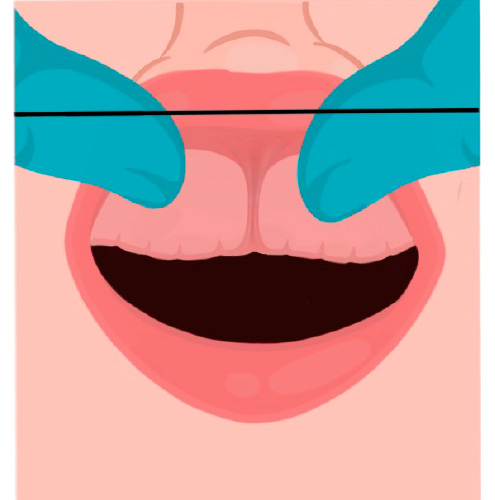What is a frenulum or labial frenulum that is too short or symptomatic?
A symptomatic frenulum that is too short usually occurs in the maxilla. One speaks of a symptomatic labial frenulum when
the connective tissue fold covered with oral mucosa.
which connects the upper lip with the upper gum, restricts the mobility of the lip because it is too short, too thick, too tight. This is called a frenulum labii breve and the condition is called ankylolabis.
Kotlow LA. Diagnosing and understanding the maxillary lip-tie (superior labial, the maxillary labial frenum) as it relates to breastfeeding. J Hum Lact. 2013 Nov;29(4):458-64. doi: 10.1177/0890334413491325. Epub 2013 Jul 2. PMID: 23821655.
How does a frenulum that is too short or symptomatic develop?
There is no concrete data explaining why lip tie occurs. A hereditary component is suspected. There is emerging evidence that the MTHFR gene plays a role in the formation of the mouth, including the lips. This study reports that people with certain MTHFR mutations have a sevenfold risk of developing cleft palate. There is still much to learn about MTHFR mutations, but researchers believe this specific genetic mutation is more common in Caucasian and Asian populations. It appears to be somewhat less common in the Native American population, and significantly less common in the black population.
How common are lip ligaments that are too short or symptomatic?
Dr. Ghaheri, an otolaryngologist at the Oregon Clinic, says a restrictive lip tie is much less common than a symptomatic tongue tie, in which a short, tight piece of tissue under the tongue limits its range of motion. A symptomatic lingual frenulum is also more likely to interfere with breastfeeding because the tongue cannot move upward. Nevertheless, a baby with a tongue-tie may have trouble breastfeeding because it is more difficult or impossible to apply the upper lip without stress and to form or hold a vacuum.
If your baby has a frenulum that is too short, does it automatically have a frenulum that is too short, or vice versa?
If a baby has a shortened labial frenulum, it does not mean that he or she also has a shortened lingual frenulum. Even children with a shortened frenulum do not automatically have a frenulum that is too short. In the womb, the area under the tongue and the area between the upper lip and the gumline develop at different times and through different processes. The belief that most babies always have both a symptomatic labial and lingual frenulum probably stems from the observation that infants often retract the upper lip to compensate for a shortened lingual frenulum, making it difficult for a baby to move one independently of the other. The two conditions should be assessed separately.
How can you tell if your baby has a shortened frenulum?
If your baby has not yet been evaluated for a labial frenulum, talk to a specialized professional if you notice the following signs of a shortened labial frenulum:
If your baby has a symptomatic frenulum
- it is unable to turn up the lips, grasp breast tissue with the mouth wide open and hold the vacuum.
- milk runs out of the corners of the mouth and air is sucked in and swallowed.
- Swallowing air can often cause flatulence, colic or even reflux .
- it has a dominant sucking vesicle on the center of the lips
- breastfeeding may be impaired as a result.
If your baby has a symptomatic frenulum, the mother can:
- Have pain when feeding.
- have damaged or deformed nipples (often a lipstick shape can be seen)
- Develop constipation, clogged milk ducts or mastitis
- have problems with the milk supply.
Can a frenulum cause speech problems?
A labial frenulum rarely causes speech problems later in life. It’s rare, but Dr. Ghaheri says, “In some severe cases, if the lip frenulum causes the child discomfort when opening the mouth because of the tension, it may alter their oral anatomy to minimize the pain, which can affect speech.” If you suspect that a lip tie is affecting your child’s speech development, seek consultation with a speech therapist(s).
Can a frenulum cause tooth decay?
Breast milk does not produce caries, dirt niches and insufficient care do.
In babies, an uncorrected frenulum can lead to tooth decay, especially in the baby’s upper front teeth.
According to Dr. Lawrence Kotlow, a lip frenulum prevents residual milk from draining from the area between the upper lip and gums when drinking from a bottle, which eventually leads to bottle decay.
To prevent tooth decay, Dr. Kotlow recommends that parents pay special attention to oral hygiene as soon as the upper front teeth erupt and make sure there is no milk residue in the baby’s mouth after feeding.
If your child shows signs of enamel wear – white spots or discoloration – see a dentist to create an action plan for better oral hygiene and to determine if corrective treatment is needed.
Can a frenulum that is too short lead to a gap between the permanent anterior teeth?
Gaps between the milk teeth are normal and desirable, as the future permanent teeth need more space.
A labial frenulum can cause a gap between the two permanent front teeth if the labial frenulum is so strong that there is an indentation at the gumline.
If the labial frenulum is less pronounced, the gap may be temporary and close as other teeth move in.
Tooth gaps have complex causes. A labial frenulum separation does not guarantee that there will be no gap between the front teeth or that an existing gap will be closed.
In case of doubt, if there are no problems with breastfeeding, we recommend waiting until all the teeth are in before doing a lip frenulum revision and assessing the condition at around 6 years of age if necessary.
What do lip frenulum look like?
Kotlow (2015) describes his classification system as follows: The upper lip can be classified by assessing the inner mucosal attachment of the lip. If the labial attachment inserts in the zone where the two upper anterior teeth will emerge and extends beyond the alveolar ridge into the palatal area, the labial frenulum is classified as Class IV, insertion in the zone directly in front of the palatal area between the area of the future two anterior teeth is a Class III frenulum, insertion in the border area of the free (dark pink) and attached (pale pink) gingiva is identified as a Class II frenulum, and if the attachment is above this area, it is identified as a Class I.
| Classification of the upper labial frenulum according to Kotlov | |
| Class | Description |
| I | High attachment point of the labial frenulum with no connection between lip and gum |
| II | Attachment point of the labial frenulum at the border between unattached (red) and attached (pale pink) oral mucosa. |
| III | Attachment point of the labial frenulum between the eruption point of the future incisors and the center of the alveolar ridge |
| IV | Point of attachment of the labial frenulum between the center of the alveolar ridge and the hard palate |
Kotlow L TOTS-Tethered Oral TissuesThe Assessment and Diagnosis of theTongue and Upper Lip Ties in BreastfeedingGeneral Dentistry March 2015.
Townsend et al (2013) writes, the median upper lip frenulum (MMLF) is a mucosal fold on the underside of the middle of the upper lip associated with the midline of the attached gingiva between the central incisors. As the primary teeth erupt, the height of the alveolar structures usually increases and the attachment of the labial frenulum moves upward with the alveolar ridge.
TownsendJA, BrannonRB, CheramieT, HaganJ, Prevalence and variations of the median maxillary labial frenum in children, adolescents, and adults in a diverse populationGeneral DentistryMarch/April 2013.
These anatomical descriptions do not indicate whether the labial frenulum will cause problems during drinking or future problems as the anatomy changes due to the growth of the alveolar ridge.
Therefore, in 2020, Dr. Darius Moghtader developed the Mobility-Scale Lip Band (M-S-L) for lip mobility to better classify and assess the potential impact of upper lip mobility on breastfeeding.
Lip with M-SCALE 3 (large restriction)

The labial frenulum attaches to the masticatory ridge up to the palate and has created an indentation in the masticatory ridge due to the strong traction.
The upper lip cannot be turned up over the nostrils.
The upturning of the upper lip creates stress in the tissue, which can be recognized by the white coloration, i.e. the reduced blood flow.
The upper lip shows a dip in the middle when lifting or fish mouth and turns white as a sign of stress.
Lip with M-SCALE 2 (medium restriction)

The labial frenulum attaches to the chewing surface.
The lip frenulum can only be turned up to below the center of the nostrils.
The upturning of the upper lip creates stress in the tissue, which can be recognized by the white coloration, i.e. reduced blood flow.
The upper lip is straight and may turn white as a sign of stress.
Lip with M-SCALE 1 (small restriction)

The labial frenulum attaches below the chewing line.
The lip can be turned up over half of the nostrils.
Turning up the upper lip does not create stress in the tissue.
The upper lip is rounded when raised or fish mouth and remains unchanged in color.
Lip with M-SCALE 0 (no restriction)

The labial frenulum attaches below the chewing line.
The lip can be put on fully over the nostrils.
Turning up the upper lip does not create stress in the tissue, blood flow remains unchanged.
The upper lip is relaxed fully rounded and remains unchanged in color.
Graphics and design: klossannaliska@gmail.com
